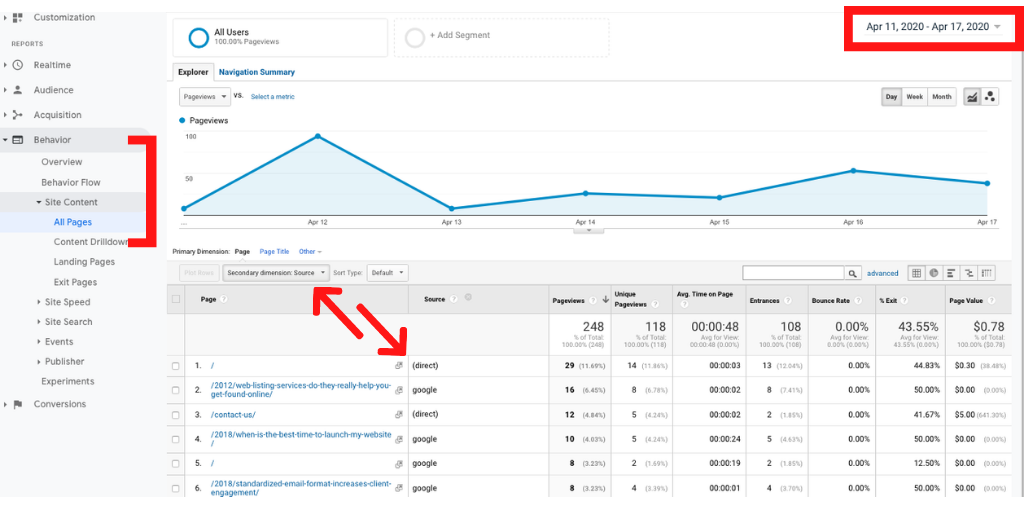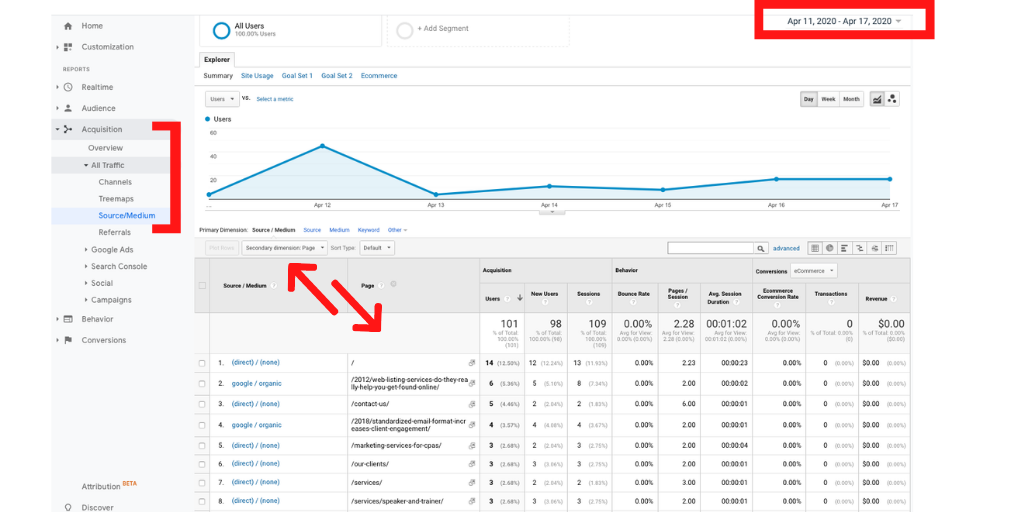If you spend a lot of time creating content for your website, social media posts, and advertising you want to know if your efforts are working.
Here are five important questions to answer to determine if what you’re creating is relevant and if it’s paying off. Download the ebook to get all this information in an easy-to-reference format.
How many people look at the content?
If you’re using Google Analytics to measure website metrics, you can tell just how many people are looking at content across your site. Plus, you can see how they access the content, which helps inform where to spend the most effort.
Do this by logging into your Google Analytics account. On the left navigation bar:
- Go to Behavior > Site Content > All Pages
- Choose the time frame you want to monitor (top, right corner)
- Add a Secondary dimension: Source to view how people are finding the content.
This screenshot shows the content most visited on a site from April 11 – 17, 2020. It also shows how people accessed the content. In this example, direct means they accessed the content either by typing the website URL into a browser or access the site through browser bookmarks.

Some of the other success indicators in this view are the Bounce Rate, which you want to be as low as possible. Plus, the Avg. Time on Page, which indicates how long a viewer spends looking at the content.
Do people view more than one page when they visit the site?
That is also answered with Bounce Rate data. Bounce rate indicates when a person enters and leaves the same page without visiting another page. So, if your content has links in it or provides additional resources or a form, and no-one is clicking the links, then the bounce rate would be very high. If they are clicking on links and visiting other pages on the site, the bounce rate would be low.
How are people finding my stuff?
This is a very relevant question, especially if you use social media or advertising to draw people to your site. If you find the audience it not visiting you from a source where you’re spending money, revisit and modify the ad spend, ads themselves, and/or the call to action.
Here’s how visitors find your content. On the left navigation bar:
- Go to Acquisition > Source/Medium
- Choose the time frame you want to monitor (top, right corner)
- Add a Secondary dimension: Page to view the pages people accessed using that source/medium.

That tells you not only what pages people are accessing, but how they accessed it. If you’re not getting the return you seek, then decide if the medium/source should be dropped, or if you need to revisit the content itself.
Who is looking at my content?
As a business owner, you have probably defined a desired target market for your products or services. But, are you sure that’s who is visiting your website? Get the answer in your analytics. Plus, find out even more about the audience who is viewing your content.
Here’s how.
On the left navigation bar:
- Choose the time frame you want to monitor (top, right corner)
- Go to Audience > Demographics > Age (view the information; does it align with your target?)
- Go to Audience > Demographics > Gender (view the information; does it align with your target?)
- Go to Audience > Interests > Overview\

This data tells you the interests and in-market segments for those who visit the site during the time frame specified.
Why is this important?
It’s important for a few reasons. If you see common in-market trends over a period of time, those people are more likely to purchase products or services in the specified category (on the left side).
Affinity categories are used to reach potential customers, to make them aware of your brand or product. These are more likely people searching for information about a topic or those who know what their problem is and who are seeking a solution.
This information is really relevant to determine if the people you are targeting are actually the ones visiting. It also gives you a snapshot of secondary audiences who are interested in your content. They could be a new advertising audience or social media group to focus your content development efforts.
Now that you know the what, how, who, and why, it’s time to determine if you need to make an adjustment to your content or keep doing what you’re doing.

